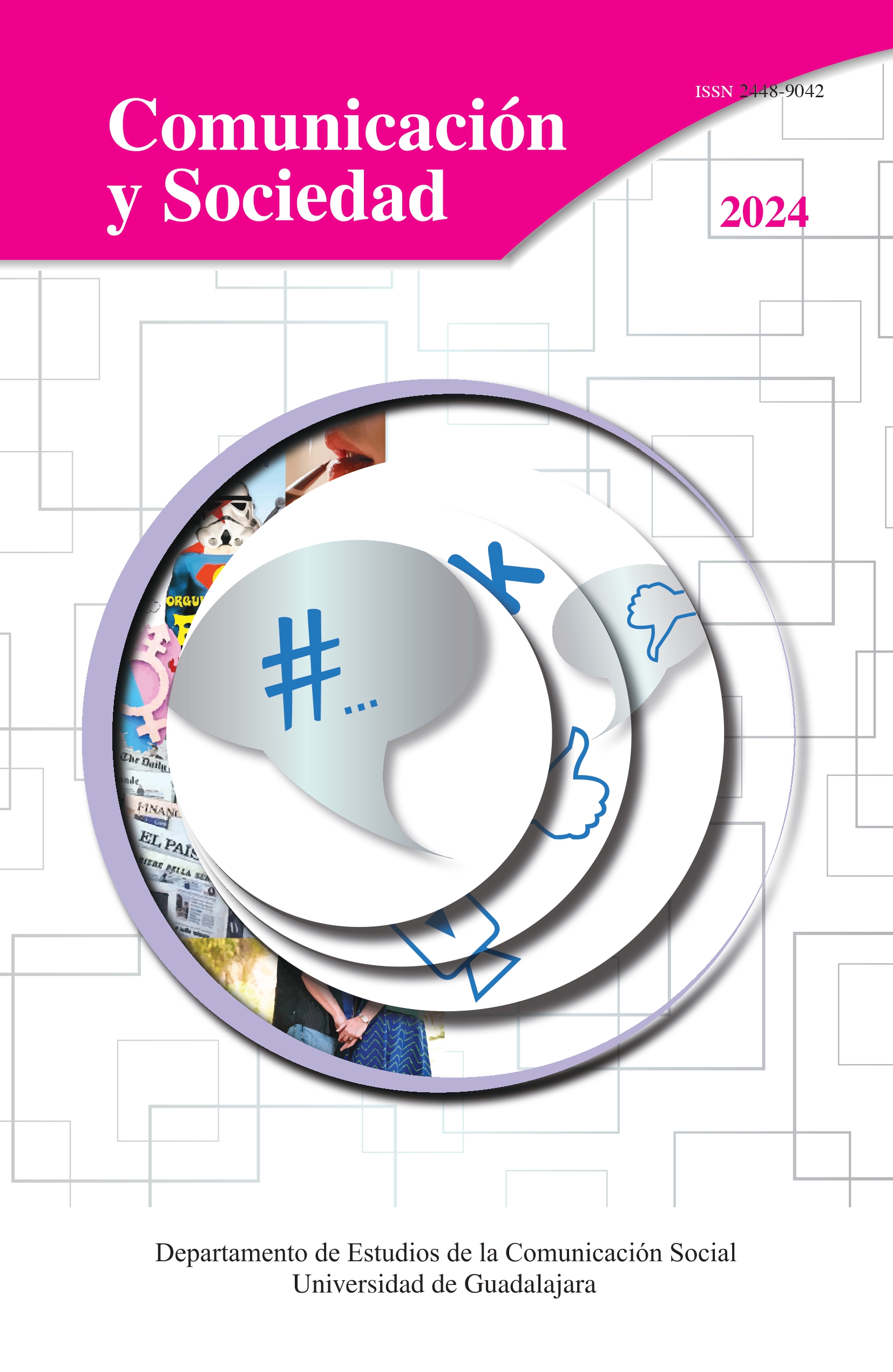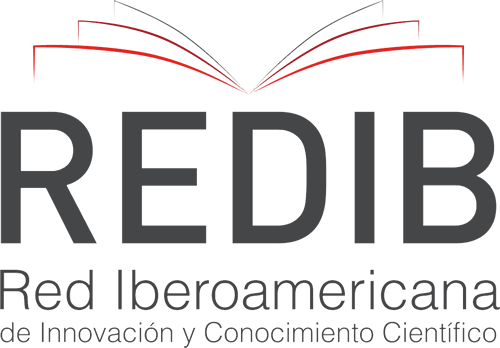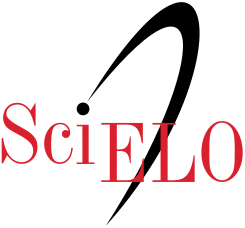Bienestar animal en Instagram: tendencias y discurso de eco-influencers uruguayos
DOI:
https://doi.org/10.32870/cys.v2024.8675Palabras clave:
Influencers, Bienestar animal, Discurso público, Redes socialesResumen
Se realiza análisis del discurso multimodal en las publicaciones de un año (n = 200) de 17 eco-influencers uruguayos en Instagram, con énfasis en los posts que abordan la agenda emergente del bienestar animal. Así, se encuentra un predominio del discurso del proteccionismo en defensa de animales silvestres y un foco en la acción de los consumidores. El estudio contribuye a la comprensión de los términos en los que nuevos actores influyentes en nuevos contextos digitales se expresan sobre estas temáticas.Descargas
Citas
Acosta, A. (2013). El Buen Vivir. Sumak Kawsay, una oportunidad para imaginar otros mundos. Icaria.
Aguiar, S. & Cerqueira, J. F. (2012). Comunicação ambiental como campo de práticas e de estudos. Comunicação & Inovação, 13(24). https://doi.org/10.13037/ci.vol13n24.1474
Alimonda, H. (Comp.) (2011). La Naturaleza Colonizada – Ecología Política y Minería en América Latina. CLACSO/Ciccus.
Amico B., Oliveira A. & Zeler I. (2020). La comunicación de la emergencia climática en las redes sociales de los activistas ambientales: el caso de Greta Thunberg, Leonardo DiCaprio y Arturo Islas Allende. Pensar en la Publicidad. Revista Internacional de Investigaciones Publicitarias, 14(2), 281-290. https://doi.org/10.5209/pepu.72129
Anderson, A. (1997). Media, culture and the environment. Rutgers University Press.
Anderson, A. (2021). Sustainability in Environmental Communication Research: Emerging Trends and Future Challenges. In F. Weder, L. Krainer & M. Karmasi, The Sustainability Communication Reader: A Reflective Compendium (pp. 31-50). Springer Nature.
Ardèvol, E., Martorell, S. & San-Cornelio, G. (2021). El mito en las narrativas visuales del activismo medioambiental en Instagram. Comunicar, 69, 59-70. https://doi.org/10.3916/C68-2021-05
Bentley, K., Chu, C., Nistor, C., Pehlivan, E. & Yalcin, T. (2021). Social media engagement for global influencers. Journal of Global Marketing, 34(3), 205-219. https://doi.org/10.1080/08911762.2021.1895403
Brereton, P. & Gómez, V. (2020). Media Students, Climate Change, and YouTube Celebrities: Readings of Dear Future Generations: Sorry Video Clip. ISLE: Interdisciplinary Studies in Literature and Environment, 27(2), 385-405. https://doi.org/10.1093/isle/isaa021
Brockington, D. (2009). Celebrity and the environment: Fame, wealth and power in conservation. Bloomsbury Publishing.
Cannata, J. P. (2016, July). Escándalos, discurso público y agendas sensibles emergentes. Ponencia en el Congreso ALICE. Universidad Austral, Argentina.
Castells, M. (2013). La sociedad red: Una visión global. Alianza Editorial.
Centro de Estudios en Comunicación Aplicada. (2019). El bienestar animal en el discurso público: polarización y representaciones sociales del concepto zoológico en Argentina. Facultad de Comunicación, Universidad Austral.
Corbett, J. (2006). Communicating Nature: How We Create and Understand Environmental Messages. Island Press.
Dekoninck, H. & Schmuck, D. (2022). The mobilizing power of influencers for pro-environmental behavior intentions and political participation. Environmental Communication, 16(4), 458-472. https://doi.org/10.1080/17524032.2022.2027801
Deuze, M. (2012). Media Life. Polity Press.
Eddy, K. (2022, June 15th). The Changing News Habits and Attitudes of Younger Audiences. Reuters Institute, Digital News Report 2022. https://reutersinstitute.politics.ox.ac.uk/digital-news-report/2022/young-audiences-news-media
Erviti Ilundáin, M.C., León, B., Urruchi, P. & Martínez García, A. B. (2023). ¿Está Twitter en una emergencia climática? La difusión de los términos "crisis climática" y "emergencia climática" y la influencia de Greta Thunberg en el discurso público. Observatorio (OBS*), 17(3). https://obs.obercom.pt/index.php/obs/article/view/2130
Escobar, A. (2000). El lugar de la naturaleza y la naturaleza del lugar:¿globalización o postdesarrollo? CLACSO.
Equipos Consultores (2022). Centennials. Estilos de vida, proyección y consumo. Uruguay.
Fiske, J. (1987). Television culture. Methuen.
Garzón, C. & Gómez Márquez, V. (2023). Análisis multimodal del discurso de ecoinfluencers uruguayos en Instagram. Contratexto, (39), 115-136. https://doi.org/10.26439/contratexto2023.n39.6141
Gómez, V. (2021). Mediations of Environmental Risk: Engagement of Young Audiences in Uruguay and Ireland. DCU.
Gómez Márquez, V. & Besada, I. (2022). Cambio climático y comunicación en clave juvenil. In V. Gómez Márquez, I. Besada, J. Gari, C. Garzón, A. Gómez, D. Jurburg & A. Pérez, Comunicación y respuestas al cambio climático en Uruguay (pp. 14-35). Universidad de Montevideo.
Halpern, D., Rosenberg, A. & Arriagada, E. (2013). Who are those Green Guys? Understanding Online Activism in Chile from a Communicational Perspective. Palabra Clave, 16(3), 729-759. https://doi.org/10.5294/pacla.2013.16.3.3
Hautea, S., Parks, P., Takahashi, B. & Zeng, J. (2021). Showing they care (or don’t): Affective publics and ambivalent climate activism on TikTok. Social Media + Society, 7(2), 1-14. https://doi.org/10.1177/20563051211012344
Jewitt, C. (2016). Multimodal analysis. In A. Georgakopoulou & T. Spilioti (Eds.), The Routledge Handbook of Language and Digital Communication (pp. 69-84).
Keane, J. (1995). Structural transformations of the public sphere. The Communication Review, 1(1), 1-22. https://doi.org/10.1080/10714429509388247
Kress, G. & Leeuwen, T. (1996). Reading Images: The Grammar of Visual Design. Routledge.
Lazarsfeld, P., Berelson, B. & Gaudet, H. (1944). The people's choice: how the voter makes up his mind in a presidential campaign. Columbia University Press.
Leff, E. (1995). Green production: toward an environmental rationality. Guilford Press.
Martínez Alier, J. (1991). Ecology and the poor: A neglected dimension of Latin American history. Journal of Latin American Studies, 23(3), 621-639. https://doi.org/10.1017/S0022216X0001587X
Martínez Alier, J. (2011). El ecologismo de los pobres: Conflictos ambientales y lenguajes de valoración. Icaria.
Marwick, A. (2015). You May Know Me From YouTube: (Micro)-Celebrity in Social Media. In P. Marshall, & S. Redmond, A Companion to Celebrity (pp. 333-350). JohnWiley & Sons.
McGuire, L., Palmer, S. B. & Faber, N. S. (2022). The development of speciesism: age-related differences in the moral view of animals. Social Psychological and Personality Science, 14(2), 228-237. https://doi.org/10.1177/19485506221086182
Méndez, A. (2016). La emergencia de nuevos imaginarios socioambientales. Críticas y alternativas al especismo institucionalizado. Apuntes de Investigación del CECYP, (27), 159-185. https://www.aacademica.org/anahi.mendez/50
Nieto González, J. (2019). Microinfluencers en Instagram: estudio de popularidad y engagement [Final degree project]. Univesidad de Valladolid. https://uvadoc.uva.es/handle/10324/40392
Organización Mundial de Sanidad Animal. (2006). Código Sanitario para los Animales Terrestres. https://www.woah.org/es/
Pearson, E., Tindle, H., Ferguson, M., Ryan, J. & Litchfield, C. (2016). Can we tweet, post, and share our way to a more sustainable society? A review of the current contributions and future potential of #socialmediaforsustainability. Annual Review of Environment and Resources, 41, 363-397. https://doi.org/10.1146/annurev-environ-110615-090000
Pearce, W., Niederer, S., Özkula, S. M. & Sánchez, N. (2019). The social media life of climate change: Platforms, publics, and future imaginaries. Wiley Interdisciplinary Reviews: Climate Change, 10(3). https://doi.org/10.1002/wcc.569
Phua, J., Jin, S. V. & Kim, J. (2020). Pro-veganism on Instagram: Effects of user-generated content (UGC) types and content generator types in Instagram-based health marketing communication about veganism. Online Information Review, 44(3), 685-704. https://doi.org/10.1108/OIR-06-2019-0213
Programa de las Naciones Unidas para el Medio Ambiente. (2021). Hacer las paces con la naturaleza. https://www.unep.org/
Renzi, J., Cannata, J. & Fitz Herbert, A. (2016). Discurso público de los grupos protectores de animales enfocados en instituciones zoológicas. CECAP.
Romero-Cantero, T., González-Díaz, C. & Quintas-Froufe, N. (2022). La comunicación de los influencers veganos en Instagram: el caso español. Cuadernos.info, (52), 307-329. https://doi.org/10.7764/cdi.52.38267
Sabherwal, A., Ballew, M. T., Van der Linden, S., Gustafson, A., Goldberg, M. H., Maybach, E. W., Kotcher, J. E., Swim, J. K., Rosenthal, S. A. & Leiserowitz, A. (2021). The Greta Thunberg Effect: Familiarity with Greta Thunberg predicts intentions to engage in climate activism in the United States. Journal of Applied Social Psychology, 51(4), 321-333. https://doi.org/10.1111/jasp.12737
San Cornelio, G., Ardèvol, E. & Martorell, S. (2021). Estilo de vida, activismo y consumo en influencers medioambientales en Instagram. Obra Digital, (21), 131-148. https://doi.org/10.25029/od.2021.326.21
Schmuck, D., Hirsch, M., Stevic, A. & Matthes, J. (2022). Politics – Simply Explained? How Influencers Affect Youth’s Perceived Simplification of Politics, Political Cynicism, and Political Interest. The International Journal of Press/Politics, 27(3), 738-762. https://doi.org/10.1177/19401612221088987
Severo, E., Guimarães, J., Dellarmelin, M. & Ribeiro, R. P. (2019). The Influence of Social Networks on Environmental Awareness and the Social Responsibility of Generations. Brazilian Business Review, 16(5), 500-518. https://doi.org/10.15728/bbr.2019.16.5.5
Stuart Hall, S. (1980). Encoding/Decoding. In S. Hall, D. Hobson, A. Lowe, & P. Willis (Eds.), Culture, Media, Language: Working Papers in Cultural Studies (pp. 63-87). Hutchinson.
Svampa, M. (2008). La disputa por el desarrollo: territorio, movimientos de carácter socio-ambiental y discursos dominantes. In Cambio de época. Movimientos sociales y poder político (pp. 1-31). Siglo XXI.
Thunberg, G. & Mustill, T. (Director). (2021). For Nature [Película].
Valero, C. (2023). Diccionario emoticonos WhatsApp. ADSLZone. https://www.adslzone.net/esenciales/whatsapp/significado-emojis-whatsapp/
Vanhulst, J. (2015). El laberinto de los discursos del Buen vivir: entre Sumak Kawsay y Socialismo del siglo XXI. Polis. Revista Latinoamericana, 40. http://journals.openedition.org/polis/10727
Descargas
Publicado
Cómo citar
Número
Sección
Licencia

Esta obra está bajo una licencia internacional Creative Commons Atribución-NoComercial 4.0.
Los autores/as que publiquen en esta revista aceptan las siguientes condiciones:
De acuerdo con la legislación de derechos de autor, los autores conservan los derechos de autoría y otorgan a Comunicación y Sociedad el derecho de primera comunicación pública de la obra. Comunicación y Sociedad no realiza cargos a los autores por enviar y procesar artículos para su publicación.
Los autores/as pueden realizar otros acuerdos contractuales independientes y adicionales para la distribución no exclusiva de la versión del artículo publicado en Comunicación y Sociedad (por ejemplo incluirlo en un repositorio institucional o publicarlo en un libro) siempre que indiquen claramente que el trabajo se publicó por primera vez en Comunicación y Sociedad.











